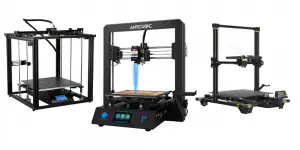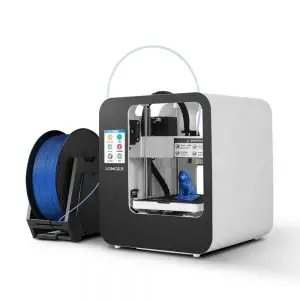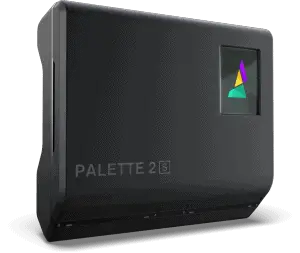Buying a 3D printer presents itself with a few challenges. You want the best printer for your budget while giving you a reasonable learning curve and a decently sized build volume. The No products found. 3D printer is moderately priced while managing to give you comparable benefits to other printers in the same price range. Here are the specs:
No products found. 3D Printer Technical Specifications
- Build Volume: 300 mm x 300 mm x 400 mm
- Build Speed: 60 – 150 mm per second with a maximum of 250 mm per second travel speed
- Filaments: PLA, ABS, TPU, Flexible Materials, Wood, HIPS, etc.
- Filament Diameter: 1.75 mm
- Nozzle: Direct Drive single Titan extruder
- Nozzle Diameter: .40 mm
- File Types: STL, OBJ, G-Code
- Software: Repetier Host, Cura, Slic3r, Simplify3D, MakerWare
- Connectivity: USB, TF Card, USB Stick
- Print Bed: Heated glass, assisted leveling
No products found.
No products found.
Perks & Features Of The No products found.
With such a large build area, you’ll enjoy the minimal assembly time with the ability to get printing right away. Many have the assembly to print within an hour of unboxing. The aluminum extrusions are thick and wider than the average 3D printer frames which makes it a sturdy piece of machinery and rather large too.
You’ll also notice the synchronized dual Z-axis on the gantry. Each side of the Z-axis is connected to each other via a pulley system so that both can move up and down at the same height and speed. This feature ensures that the X-carriage moves parallel to the build plate.
The glass print bed sits on top of the build plate and gets heated quickly. There is a thermal runaway protection sensor as well to monitor the temperature setting. A touch screen allows you to control the settings of both the print bed and the extruder within the heat option on the menu. It allows you to set the incremental increase of the temp by 1, 5, or 10 degrees Celsius. Leveling the print bed is done manually but there is an option in the controls to assist you with the five points.
Once the print bed is leveled and heated, and the extruder has reached optimal temps, you’re ready to load the filament. The filament holder sits on top of the gantry and feeds directly into the nozzle allowing for the use of different filament types. From the standard PLA to the more flexible TPU, the direct drive extruder makes building with these materials easier. A sensor will alert you if you run out of filament during a build. The extruder can also be swapped out for the .20 mm, and .30 mm options.
There may be a need to fiddle around with the heat settings a bit as you test out different materials. The part-cooling fan lags a bit in comparison to how hot the bed gets. This can cause warping and distorted builds if the layers aren’t cooling enough as the print job completes itself.
Another feature to take notice of is the power loss recovery function which allows the Sidewinder X1 to pause builds and continue from where it left off. There may be some stringing and bulging layers, but let’s take a look into the actual print function of the machine.
No products found.
Printing With The No products found.
While the print bed does need to be leveled manually, it doesn’t need much adjusting after it’s initial setup. Printing the benchy can be a hit or miss depending on the settings you use for the test build. When the print bed is heated to 60 degrees Celsius there’s a noticeable layer line going through the hull of the little tugboat.
Dimensional accuracy is pretty good, but overall you’re going to have to run a few test prints to work out a few of the kinks, especially if you’re getting a layer line around the 20 mm height mark. You should also purchase some filament if you don’t have some already since it doesn’t come with a sample roll.
Another thing you’ll notice about the Artillery Sidewinder X1 3D Printer is how quiet it is. Artillery, also known as Envovo, has taken extra steps to equip the printer with quiet stepper motors which assist the machine in minimizing as much noise as possible.
Here’s What You Get With The No products found.
When you first get the package, it’s large and marked as fragile. It’s been boxed with care and there’s been a lot of consideration given to the assembly process of the machine. With the instruction manual, you should be able to put the machine together within a half hour or so. It comes 95% assembled with you only having to connect the gantry to the build plate, and make sure the ribbon cables are connected and in place. Here’s everything you’ll in the box:
What’s in the Box?
- Gantry
- Build plate with textured glass print bed
- Instruction manual
- Warranty Card
- Hazardous warning list
- Checklist of pre-shipment quality control actions
- Power Cord
- Assembly tool pouch that includes: Hex keys, Allen wrench, 2 ribbon cables, spare wheels, USB stick, bolts, 3-color LED, and brackets.
Troubleshooting and Customer Support for the No products found.
Thankfully enough, there is a warranty on the Artillery 3D printer. The warranty can only be used by the original buyer with proof of purchase from an authorized seller. Consumable parts, the parts considered to deteriorate over time with normal use of the printer, are not covered by the 1-year warranty. They consider these parts to be:
- Heater cartridge
- Nozzle
- Part cooling fans
- LED module
- USB stick
The glass print bed is guaranteed with a flatness of .25 mm. The electronic parts of the 3D printer are only warrantied for 90 days. These parts include:
- Mainboard
- TFT screen
- TFT control
- Solid-state relay
- Power supply unit
- End-stop users
- Filament run-out sensor
- Breakout boards
- AC heated bed
The Knowledge Base tab on Envovo’s website also provides support via articles that cover a wide array of topics which include how to change materials, starting a print, how to level the build plate and much more.
If you can’t find the answers you’re looking for on the company’s website, there’s an option to submit a ticket to the Customer Support team. You’ll also get an abundance of assistance from the Facebook group too. Overall, users of the No products found. are impressed with the customer service they’ve received.
The Good and Bad of the No products found.
No products found. No products found.
No products found. Pros:
- The printer is easy to assemble and shouldn’t take more than 30 minutes even if you’re a beginner.
- The touchscreen makes navigating the settings and using the printer itself fairly easy.
- You can change the increments at which the print bed and extruder heat up by 1, 5, or 10 degrees Celsius.
- The AC heated glass bed heats up very fast.
- You’ll get reasonably good prints using the Cura slicing software at the 60 mm per second build speed.
- The build volume is large at 300 mm x 300 mm x 400 mm.
- The printer is quiet.
No products found.Cons:
- The print menu and touchscreen can be cumbersome when using a micro SD card.
- The instruction manual can be vague in places.
- Printing at high speeds with a slow part-cooling fan can cause warping and distortion in builds depending on the material being used.
- With a glass bed, if you have to change filaments in the middle of a build and allow the bed to cool down too much, the adhesion slips and ruins the build.
The Verdict
Overall, you get a lot of bang for your buck with the No products found.. Since it comes mostly assembled, you don’t have to spend too much time figuring out how to put it together. You can get printing within an hour of opening the box but make sure you have some extra filament on hand to run your first test build as it doesn’t come with a sample roll.
Last update on 2025-06-06 / Affiliate links / Images from Amazon Product Advertising API




